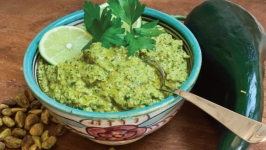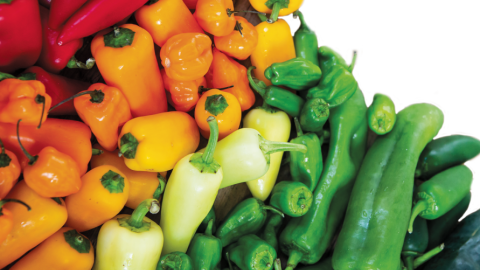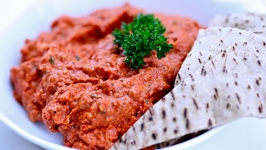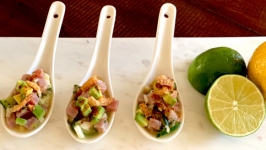Pepper Nirvana : A Guide to Picking and Plating Summer Peppers
Fiery, flavorful, nutrient-packed peppers can singlehandedly spell the difference between an ordinary meal and a banquet for the senses. For most of us, ogling colors at the farmers market is where our pepper experience ends. We know the bell pepper and perhaps one or two others, but many people overlook varieties that pack incredible flavor and cooking potential. The good news: Learning how to select and use peppers today isn’t nearly as hard as it might once have seemed.
Pick ’em: Chilies Add More Than Heat
Understanding the pungency of a pepper is critical, but it is the balance between heat, flavor and color that brings a meal to life.
The environment—when peppers are picked and how they are handled—impacts their heat and flavor. Peppers are often harvested when they are immature or green, with ripening occurring off of the vine. Flavor improves when the pepper is left to ripen to full maturity on the vine, typically when they are red, yellow or orange. Generally, the riper the chili, the hotter and sweeter it is. Fresh unripe chilies tend to be more bitter, while ripe chilies have a fuller, more complex and more rounded flavor.
When buying peppers, loose is better than packaged. That way you can carefully inspect each one. Look for plump peppers with glossy skin and firm stems, avoiding any that are wrinkled or have soft spots.
Some peppers, such as bells and jalapeños, are available year-round at supermarkets, but for summer’s pepper bounty head to farmers markets. Local farmers sell a wider selection of peppers at farmers markets during the summer. Happy Quail Farms in East Palo Alto grows peppers exclusively. Other Silicon Valley–area farms that sell peppers include Fifth Crow Farm, Borba Farms, Happy Boy Farms and Lonely Mountain Farm.
Pepper varieties mature at different times during the summer. Fifth Crow Farm in Pescadero, for example harvests slightly later in the season. “Our peppers will be available at market starting in August, possibly September. The foggy coastal climate of Pescadero is conducive to growing sweet peppers such as the Purple Islander, a purple bell pepper with a mild citrusy flavor; and Carmen, a gypsy pepper that is sugary sweet. This year for the first time we are trailing cornets, which are a miniature version of the Italian frying pepper,” says Harvest Manager Jacob Dawes.
Farmers are excellent resources on varieties and cooking methods. So strike up a conversation with them next time you’re at the farmers market. They’ll know the heat and flavor profiles that will best suit your cooking plans. Experimenting with and tasting peppers is a great and fun way to understand a pepper’s heat and flavor profile.
Preserve ’em: Storing Peppers
Peppers are easy to take care of. Wash them with water, dry thoroughly and either leave them out at room temperature for up to two days or pop them in the refrigerator in an unsealed bag, where they can last up to three weeks.
For the adventurous, drying peppers at home is a wonderful way to use peppers that are close to being overripe. Peppers can be dried whole or cut into strips and baked in the oven at a low temperature or in a countertop dehydrator. Dried peppers can be ground into spice mixtures or infused in oils and pickling liquids for a burst of flavor.
![]()
Plate ’em: Cooking Tips for Delicious Dishes
There are as many ways to incorporate peppers into a meal as there are varieties of peppers. Cooking and applying heat to a fresh pepper through roasting, sautéing or fermenting in acid intensifies the flavor of the pepper and softens the somewhat bitter taste of a raw pepper’s flesh.
Roasting peppers deepens the flavor, at the same time allowing for easy removal of the skin. The ideal peppers for roasting are large peppers with thicker skins such as bells, Anaheim and New Mexico peppers.
Peppers sautéed with other aromatics and vegetables such as onions, garlic and tomatoes can be served as a side dish or relish over proteins, pasta, rice or eggs. Any pepper can be sautéed, regardless of size or thickness of skin. Padron and shishito peppers are best eaten whole after sautéing in olive oil over high heat just long enough to blister. Serve with a sprinkle of flaky sea salt and a squirt of lemon juice.
Hot peppers such as habanero, Thai, cayenne and chipotle are ideal for processing into salsas, spices or simply dried whole. David Winsberg of Happy Quail Farms notes:
“One of the newer, more interesting peppers people can look forward to this summer is the aji amarillo, originally from Peru and currently only grown in Silicon Valley. It brings a habanero pepper flavor without the killer heat.” –David Winsberg, Happy Quail Farms
All peppers carry heat in their membranes and seeds. Wearing gloves will prevent irritation to your skin. Slice off about a quarter inch of the stem end of the pepper to easily remove it from the body. Cut the pepper in half and, using the tip of a knife, remove the remaining membranes and seeds.
Taking some of the mystery out of cooking with peppers is mostly overcoming the fear of trying different varieties and exploring their versatility. Keep the recipe simple to let the pepper’s flavor and spice shine. And enjoy a little magical summer heat from local farmers this year.
Recipes and Top Pepper Picks
The Bay Area loves the summer heat and summer peppers. See our list of best local peppers worth trying and buying, including flavor notes, appearance and cooking techniques. This season, peppers offer a rainbow of colors and flavors to choose from, with the Poblano topping our list for it's richness, flavor and ability to work in both cooked and chopped dishes.
Here's two blissful Poblano pepper recipes you'll want to serve this season – One Skillet Poblano and Red Pepper Shakshuka, a one-pan egg and pepper dish and Roasted Poblano Pistachio Pesto, a new twist on pesto using pistachios and poblanos makes a dip or dish lip-smacking good. You can dial up the heat and vary the peppers to your taste in each recipe. Mix it up!








